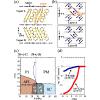当前位置:
X-MOL 学术
›
Phys. Rev. B
›
论文详情
Our official English website, www.x-mol.net, welcomes your feedback! (Note: you will need to create a separate account there.)
Spin structure at zero magnetic field and field-induced spin reorientation transitions in a layered organic canted antiferromagnet bordering a superconducting phase
Physical Review B ( IF 3.7 ) Pub Date : 2020-07-01 , DOI: 10.1103/physrevb.102.035102 Kohsuke Oinuma , Naoki Okano , Hitoshi Tsunakawa , Shinji Michimura , Takuya Kobayashi , Hiromi Taniguchi , Kazuhiko Satoh , Julia Angel , Isao Watanabe , Yasuyuki Ishii , Hiroyuki Okamoto , Tetsuaki Itou
Physical Review B ( IF 3.7 ) Pub Date : 2020-07-01 , DOI: 10.1103/physrevb.102.035102 Kohsuke Oinuma , Naoki Okano , Hitoshi Tsunakawa , Shinji Michimura , Takuya Kobayashi , Hiromi Taniguchi , Kazuhiko Satoh , Julia Angel , Isao Watanabe , Yasuyuki Ishii , Hiroyuki Okamoto , Tetsuaki Itou

|
We attempted to assign the spin structure of a layered organic antiferromagnet, -(d8-BEDT-, which is a key material located closest to the Mott boundary at ambient pressure among this family of compounds, by investigating its macroscopic magnetization thoroughly, motivated by a recent successful assignment of the spin structure of an isostructural material, -(BEDT- [BEDT-TTF and d8-BEDT-TTF are bis(ethylenedithio)tetrathiafulvalene and its deuterated molecule, respectively]. We measured the isothermal magnetization after careful choice of the measurement temperatures and cooling speed at around 80 K, so that the magnetism of the antiferromagnetic phase can be effectively extracted. Consequently, we observed hysteresis loops signifying ferromagnetism and steplike behavior when the magnetic field applied parallel to the crystallographic and axes was swept, respectively. The possible spin structure consistent with these results was discussed in terms of probable interactions between the spins, such as exchange interactions and the Dzyaloshinskii-Moriya interaction. Eventually, we asserted that -(d8-BEDT- has a spin structure with the easy axis being the axis and the net canted moment parallel to the axis, which is surprisingly different from that of -(BEDT-. We suggested that this difference originates from the difference of the sign of the interlayer interaction between the two materials. We also elucidated the overall picture of the magnetization processes of this material under the magnetic fields parallel to the three principle axes, which are also in contrast to those of -(BEDT-. In particular, the spin-reverse transition at which half of the spins rotate by was not induced by the -axis magnetic field, as in the case of -(BEDT-, but by the -axis magnetic field. Finally, numerical simulations and magnetic symmetry analysis enabled us to confirm the validity of the spin structures proposed for the two antiferromagnets under zero and high magnetic fields.
中文翻译:

边界为超导相的分层有机倾斜反铁磁体中零磁场下的自旋结构和场致自旋重取向转变
我们尝试分配层状有机反铁磁体的自旋结构, -(d8-BEDT-,这是该系列化合物中在环境压力下最接近莫特边界的一种关键材料,这是由于最近成功地确定了同种结构材料的自旋结构而对宏观磁化进行了深入研究, -(BEDT-[BEDT-TTF和d8-BEDT-TTF分别是双(亚乙基二硫代)四硫富瓦烯及其氘代分子]。在仔细选择测量温度和约80 K的冷却速度之后,我们测量了等温磁化强度,以便可以有效地提取反铁磁相的磁性。因此,当磁场平行于晶体学方向施加时,我们观察到磁滞回线表示铁磁性和阶梯状行为 和 轴分别被扫过。根据自旋之间的可能相互作用,如交换相互作用和Dzyaloshinskii-Moriya相互作用,讨论了与这些结果一致的可能的自旋结构。最终,我们断言-(d8-BEDT- 具有自旋结构,易轴为 轴和净倾斜力矩平行于 轴,这与 -(BEDT-。我们认为,这种差异源自两种材料之间的层间相互作用的符号不同。我们还阐明了该材料在平行于三个主轴线的磁场下的磁化过程的总体图,这也与磁场的相反。-(BEDT-。特别是一半旋转的自旋-反向过渡 不是由 轴磁场,例如 -(BEDT-,但是 轴磁场。最后,数值模拟和磁对称分析使我们能够确认在零磁场和高磁场下为两个反铁磁体提出的自旋结构的有效性。
更新日期:2020-07-01
中文翻译:

边界为超导相的分层有机倾斜反铁磁体中零磁场下的自旋结构和场致自旋重取向转变
我们尝试分配层状有机反铁磁体的自旋结构, -(d8-BEDT-,这是该系列化合物中在环境压力下最接近莫特边界的一种关键材料,这是由于最近成功地确定了同种结构材料的自旋结构而对宏观磁化进行了深入研究, -(BEDT-[BEDT-TTF和d8-BEDT-TTF分别是双(亚乙基二硫代)四硫富瓦烯及其氘代分子]。在仔细选择测量温度和约80 K的冷却速度之后,我们测量了等温磁化强度,以便可以有效地提取反铁磁相的磁性。因此,当磁场平行于晶体学方向施加时,我们观察到磁滞回线表示铁磁性和阶梯状行为 和 轴分别被扫过。根据自旋之间的可能相互作用,如交换相互作用和Dzyaloshinskii-Moriya相互作用,讨论了与这些结果一致的可能的自旋结构。最终,我们断言-(d8-BEDT- 具有自旋结构,易轴为 轴和净倾斜力矩平行于 轴,这与 -(BEDT-。我们认为,这种差异源自两种材料之间的层间相互作用的符号不同。我们还阐明了该材料在平行于三个主轴线的磁场下的磁化过程的总体图,这也与磁场的相反。-(BEDT-。特别是一半旋转的自旋-反向过渡 不是由 轴磁场,例如 -(BEDT-,但是 轴磁场。最后,数值模拟和磁对称分析使我们能够确认在零磁场和高磁场下为两个反铁磁体提出的自旋结构的有效性。



























 京公网安备 11010802027423号
京公网安备 11010802027423号